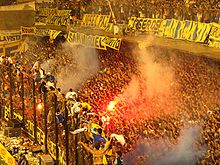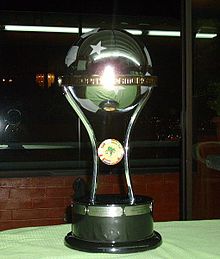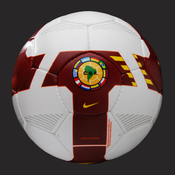- Copa Sudamericana
-
"Sudamericana" redirects here. For the extinct mammal, see Sudamerica.
Copa Sudamericana 
Founded 2002 Region South America (CONMEBOL) Number of teams 39 Current champions  Independiente (1st title)
Independiente (1st title)Most successful club  Boca Juniors (2 titles)
Boca Juniors (2 titles)Website Official Website  2011 Copa Sudamericana
2011 Copa SudamericanaThe Copa Bridgestone Sudamericana de Clubes (Portuguese: Copa Bridgestone Sul-Americana), known simply as the Copa Sudamericana (Portuguese: Copa Sul-Americana), is an annual international club football competition organized by the CONMEBOL since 2002.[1] It is the second most prestigious club competition in South American football. Despite being organized by CONMEBOL, CONCACAF clubs were invited between 2004 and 2008.[2] Clubs qualify for the competition based on their performance in their national leagues and cup competitions.
The competition began in 2002 after the discontinuation of the Copa Merconorte and Copa Mercosur.[3][2] Since its introduction, the competition has been a pure elimination tournament with the number of rounds and teams varying from year to year. As of April 2010, 39 teams qualify to the Copa Sudamericana. The tournament has been won by seven different teams and played eight times. The Copa Sudamericana is considered a merger of defunct tournaments such as the Copa CONMEBOL, Copa Mercosur and Copa Merconorte.[4][5][6][7][8] The winner faces the Copa Libertadores' champion the following year in the Recopa Sudamericana.[9]
The current champion is Argentine club Independiente, while the most successful team in the competition is Argentine side Boca Juniors, who have won the trophy twice. Boca Juniors is also the only team to have successfully defended the title.
Contents
History
See also: List of Copa Sudamericana winners, Supercopa Sudamericana, Copa CONMEBOL, Copa Mercosur, and Copa MerconorteIn 1992, the Copa CONMEBOL was an international football tournament created for South American clubs that did not qualify for the Copa Libertadores and Supercopa Sudamericana.[10] This tournament was discontinued in 1999 and replaced by the Copa Merconorte and Copa Mercosur. These tournaments started in 1998 but were discontinued in 2001.[11][12] A Pan-American club cup competition was intended, under the name of Copa Pan-Americana, but instead, the Copa Sudamericana was introduced in 2002 as a single-elimination tournament with the reigning Copa Mercosur champion, San Lorenzo.[13] Brazilian clubs did not participate in the 2002 edition due to many conflicting, organizational issues and scheduling conflicts with the Campeonato Brasileiro. San Lorenzo would go on to become the first ever winners of the competition after thrashing Atlético Nacional 4-0 on aggregate.
In 2003, the Japanese automobile manufacturer Nissan Motors started sponsoring the tournament. Thus, the competition has since been officially called Copa Nissan Sudamericana, much in the style of the Copa Libertadores branding as Copa Toyota Libertadores at the time. Also, Brazilian teams participated for the first time.
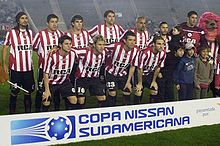 Juan Sebastián Verón captained Argentine club Estudiantes to the finals of the 2008 Copa Sudamericana.
Juan Sebastián Verón captained Argentine club Estudiantes to the finals of the 2008 Copa Sudamericana.
The 2003 tournament was swept through by the surprising Cienciano as Germán Carty's goals took los imperiales to the first international title won by a Peruvian club. In the finals, Cienciano managed to hold the powerful River Plate 3-3 in Buenos Aires and managed to come up on top 1-0 on national soil to claim the spoils. After a disappointing 2004 season, Boca Juniors managed to regain some composure as they won the trophy consecutively in 2004 and 2005 defeating Club Bolívar and Pumas de la UNAM, respectively. After the failures of UNAM and Cruz Azul in the 2001 season of the Copa Libertadores, Mexican football finally managed to inscribe themselves in the list of winners of South American club football as Pachuca defeated Colo-Colo, led by two magnificent figures such Matías Fernández and Humberto Suazo. In a highly-charged atmoshere in Santiago's Estadio Nacional, Suazo brought the home team one up on the scoreboard but two second half goals from Damián Álvarez and Christian Giménez sealed the victory for a highly-spirited team. Their compatriots, Club América, tried to emulate their success but las águilas fell short on the 2007 final as Arsenal won the title thanks to a late and inspirational strike by Martín Andrizzi seven minutes from full time in the second leg.
Having already won the Copa Libertadores and Recopa Sudamericana, Internacional, with goals from Alex and Nilmar, became the first Brazilian team to win the cup, after a near-unbeaten campaign that includes eliminating their archrivals Grêmio, defeating Boca Juniors at the Bombonera, and then defeating Estudiantes in the final.[14] Internacional's only defeat came in the second leg as they were beaten 0-1 by Estudiantes before extra time took place. In a rematch of the 2008 final of the Copa Libertadores, LDU Quito defeated Fluminense in the finals of the 2009 edition. Just like in their previous triumph, los albos lifted the trophy in the legendary Estádio do Maracanã to earn their third international title in history (as well as their nations). Argentina's Independiente won the 2010 competition after defeating Goiás of Brazil by penalties in the final.
Format
Qualification
Each national association is assigned a number of entries determined by CONMEBOL and the associations decide how to fill those slots. These can include: performance over the first semester of the year; best teams from previous season that did not qualify for the Copa Libertadores; a qualifying tournament previous to the competition, etc. The tournament itself is played in two-legged knockout stages. In addition, the defending champion receives a bye to the Round of 16. The champion of the Copa Sudamericana is guaranteed a spot in the following year's Copa Libertadores.
The competitors of the 2010 edition were distributed as follows:
- The defending champion
- 8 from Brazil
- 6 from Argentina
- 3 from Bolivia, Chile, Colombia, Ecuador, Paraguay, Peru, Uruguay, and Venezuela each
Tournament
The tournament starts in the first stage in which a number of clubs, currently 16, are paired in a series of two-legged knockout ties.[15][16] The eight survivors join 22 clubs in the second stage, in which they are paired again in another series of two-legged knockout ties.[15] The winner then progress to the round of 16, the first of four stage that work on a single elimination phases knockout system that culminates in the finals.[15]
During each stage of the tournament, ties are decided on points, followed by goal difference, away goals, then a penalty shootout after full time of the second leg, if necessary.[15] The exception is the finals, which uses two fifteen-minute extra periods instead of the away goals rule.[15]
La Otra Mitad de La Gloria
See also: Copa Sudamericana trophyLa Otra Mitad de La Gloria (The other half of glory) is a promotional Spanish phrase used in the context of winning or attempting on winning the Copa Sudamericana.[17] It is a term widely used by Latin American media. The tournament itself has become highly regarded among its participants since its inception. In 2004, Cienciano's conquest of the trophy ignited a party across Peru.[18] The Mexican football federation regards Pachuca's victory in 2006 as the most important title won by any Mexican club.[19] Sports Illustrated qualified Arsenal, unlikely contenders for the 2007 edition, as "the underdog that couldn't be stopped".[20] Internacional, following a dismal 2007 season, resurged with the 2008 title to eventually win the 2010 Copa Libertadores.
Sponsorship
The first primary sponsor of the tournament was Nissan Motors. As part of their sponsorship agreement, the name of the tournament was official called the Copa Nissan Sudamericana. Their sponsorship agreement with CONMEBOL lasted until 2010. In 2011, the tournament's primary became Bridgestone Corporation, a multinational rubber conglomerate headquartered in Japan. As the main sponsor of the tournament, the competition will carry the name of the company and, thus, the competition is known officially as Copa Bridgestone Sudamericana. The competition has had many secondary sponsors that invests in the tournament; many of these sponsors are nationally based but has expanded to other nations. Embratel, a brand of Telmex, is the only telecommunications sponsor of the tournament.[21] The tournament's current secondary sponsors are:
- Visa Inc.[21]
- Fox Sports (Fox Sports en Latinoamérica and Fox Sports en Español are the brands advertised.)[21]
- Embratel[21]
- SanDisk[21]
- T&T Sports Marketing
- Panasonic Corporation[21]
- Casio[21]
Nike supplies the official match ball, as they do for all other CONMEBOL competitions.[22] Individual clubs may wear jerseys with advertising, even if such sponsors conflict with those of the Copa Sudamericana.[15]
Match ball
The match ball for the Copa Sudamericana, manufactured by Nike, is named the Total 90 Omni CSF.[23][22] It is one of the many balls produced by the American sports equipment maker for CONMEBOL, replacing the Mercurial Veloci Hi-Vis in 2009.[24] The ball, approved by FIFA and weighting approximately 422 g, has a spherical shape that allows the ball to fly faster, farther, and more accurately.[22] According to Nike, the ball's geometric precision distributes pressure evenly across panels and around the ball. The compressed polyethylene layer stores energy from impact and releases it at launch, and the 6-wing carbon-latex air chamber improves acceleration.[22] Another feature of the ball is its rubber layer; it was designed to allow a better response while retaining the impact energy and releases it in the coup.[22] Its support material of cross-linked nitrogen-expanded foam improves its retention and durability of its shape.[22] Polyester support fabric enhances structure and stability. The asymmetrical high-contrast graphic around the ball creates an optimal flicker as the ball rotates for a more powerful visual signal, allowing the player to more easily identify and track the ball.[22]
Prize money
Clubs in the Copa Sudamericana receive $400,000 for qualifying for the competition. Afterwards, each club earns $90,000 per home match.[25] That amount is derived from television rights and stadium advertising.[25] In addition, CONMEBOL pays $500,000 to the winners.[25]
Records and statistics
 Humberto Suazo scored 10 goals, a record that still stands today.
Humberto Suazo scored 10 goals, a record that still stands today. Main article: Records and statistics of the Copa SudamericanaSee also: List of Copa Sudamericana top scorers and Historical Table of the Copa Sudamericana
Main article: Records and statistics of the Copa SudamericanaSee also: List of Copa Sudamericana top scorers and Historical Table of the Copa SudamericanaClaudio Morel Rodríguez is the only player to have won three Copa Sudamericana winners' medals.[26] The overall top goalscorer in Copa Sudamericana history is Humberto Suazo, scorer of 10 goals. Suazo also holds the record for the most goals scored in a single Copa Sudamericana. All his 10 goals were scored in the 2006 tournament.
No coach has won the tournament more than once. All Copa Sudamericana winning head coaches were natives of the country they coached to victory except for Jorge Fossati. Fossati, from Uruguay, coached Ecuadorian club LDU Quito to triumph in 2009. Mexican manager Enrique Meza coached Pachuca to win the 2006 edition, the only non-South American manager to win the title.
As of the end of the 2009 tournament, San Lorenzo has played 32 matches, the most by any team. LDU Quito have scored the most goals, netting 57. LDU Quito is the only team to be in the semifinals four times, 2004, 2009, 2010, 2011. [27]
Argentina is the country with more finalists ever, with seven appearances: San Lorenzo in 2002, River Plate in 2003, Boca Juniors in 2004 and 2005, Arsenal in 2007, Estudiantes in 2008 and Independiente in 2010.
See also
- International club competition records
- Supercopa Sudamericana
- Copa CONMEBOL
- Copa Mercosur
- Copa Merconorte
References
- ^ "SOUTH AMERICAN COMPETITIONS". rsssf.com. http://www.rsssf.com/miscellaneous/torre-sac-best.html. Retrieved 28 March 2010.
- ^ a b "Nissan South American Cup". conmebol.com. http://conmebol.com/conmebol/activeCompetition.html?x=46&sub=8&type=1. Retrieved 28 March 2010.
- ^ "SOUTH AMERICAN COMPETITIONS". rsssf.com. http://www.rsssf.com/miscellaneous/torre-sac-best.html. Retrieved 28 March 2010.
- ^ Rsssf.com
- ^ Diario On Line "Edición Nacional"
- ^ "Breve historia de la Copa Sudamericana"
- ^ Información sobre la Copa Conmebol
- ^ Globo Esporte
- ^ "Recopa Sudamerica". CONMEBOL. http://conmebol.com/conmebol/activeCompetition.html?x=47&sub=8&type=1. Retrieved 28 March 2010.
- ^ "Copa CONMEBOL". conmebol. http://conmebol.com/conmebol/activeCompetition.html?x=38&sub=8&type=1. Retrieved 28 March 2010.
- ^ "Copa Merconorte". conmebol. http://conmebol.com/conmebol/activeCompetition.html?x=71&sub=8&type=1. Retrieved 28 March 2010.
- ^ "Copa Mercosur". conmebol. http://conmebol.com/conmebol/activeCompetition.html?x=43&sub=8&type=1. Retrieved 28 March 2010.
- ^ "Copa Pan-Americana 2003". RSSSF. http://www.rsssf.com/sacups/panamcup02.html. Retrieved 28 March 2010.
- ^ "¡Internacional brillante campeón de la Copa Nissan Sudamericana!" (in Spanish). conmebol. http://www.conmebol.com/articulos_ver.jsp?id=62885&slangab=S. Retrieved 4 December 2008.[dead link]
- ^ a b c d e f (Spanish) "Reglamento de la Copa Nissan Sudamericana de Clubes 2010". CONMEBOL. April 28, 2010. http://img.mazimou.com:90/3749/documents/310.pdf. Retrieved May 18, 2010.
- ^ (Spanish) "Reglamento de la Copa Santander Libertadores de America 2010". CONMEBOL. April 28, 2010. http://img.mazimou.com:90/3749/documents/139.pdf. Retrieved May 18, 2010.
- ^ (Spanish) "Fiesta por la otra mitad de la gloria". HOY. http://www.hoy.com.ec/noticias-ecuador/fiesta-por-la-otra-mitad-de-la-gloria-423401.html. Retrieved 2010-08-24.
- ^ (Spanish) "Toda Peru festeja título de Cienciano". Fútbol Peru. http://www.peru.com/futbol/autonoticias/DetalleNoticia35407.asp. Retrieved August 5, 2010.
- ^ (Spanish) "Historia del Club Pachuca". Federación Mexicana de Fútbol Asociación. http://www.femexfut.org.mx/portalv2/aspx/WEB_ImprimirNoticia.aspx?pnIDNtca=21590. Retrieved August 5, 2010.
- ^ "Tiny Arsenal was underdog that couldn't be stopped". Sports Illustrated. December 6, 2007. http://sportsillustrated.cnn.com/2007/writers/gregory_sica/12/06/arsenal.sudamericana/. Retrieved August 5, 2010.
- ^ a b c d e f g "Image of the 2010 Copa Sudamericana draw with its sponsors clearly represented". Caracas Futbol Club. March 9, 2006. http://cdcb.com.ve/tmp/a_Sorteo1_576x324.jpg. Retrieved May 18, 2010.
- ^ a b c d e f g (Spanish) "Nike presentó la nueva pelota para el Torneo". Info Bae. 13 January 2010. http://www.infobae.com/deportes/417204-0-0-Nike-presento-la-nueva-pelota-el-Torneo. Retrieved 12 January 2010.
- ^ (Portuguese) "Netshoes - Bola Nike Total 90 Omni CSF - Copa Libertadores". Netshoes. 13 January 2010. http://www.youtube.com/watch?v=3CmTyz31eT0. Retrieved 12 January 2010.
- ^ (Spanish) "La CSF mostró el balón de la Copa Libertadores 2008". El Comercio. 13 January 2010. http://elcomercio.pe/ediciononline/HTML/2007-12-21/la-csf-mostro-balon-copa-libertadores-2008.html. Retrieved 12 January 2010.
- ^ a b c "Copa Sudamericana: Goias e Independiente juegan la final. U$ 5.000.000 en disputa". Impulso. December 2, 2010. http://www.impulsonegocios.com/contenidos/2010/12/02/Editorial_10349.php. Retrieved December 2, 2010.
- ^ "Claudio Morel Rodríguez". Boca Juniors. http://www.bocajuniors.com.ar/futbol/ficha/morel-rodriguez-claudio-marcelo. Retrieved 2010-07-02.
- ^ "Historical table". RSSSF. http://www.rsssf.com/sacups/sudamcup-allt.html. Retrieved July 2, 2010.
External links
- Conmebol.com Official Site of the Copa Nissan Sudamericana. (Spanish)
- Copa Sudamericana results at RSSSF.com
- Copa Sudamericana at worldfootball.net
- Current Copa Sudamericana News
- Copa Sudamericana en Univision (Spanish)
Copa Sudamericana de Clubes Seasons Finals 2002 · 2003 · 2004 · 2005 · 2006 · 2007 · 2008 · 2009 · 2010 · 2011 · 2012Football in South America (CONMEBOL)  Argentina (AFA)National team · Women's national team · Under-20 National team · Under-17 National team · Primera División · Copa Argentina
Argentina (AFA)National team · Women's national team · Under-20 National team · Under-17 National team · Primera División · Copa Argentina Bolivia (FBF)National team · Women's national team · Under-20 National team · Under-17 National team · Liga de Fútbol Profesional · Copa Aerosur
Bolivia (FBF)National team · Women's national team · Under-20 National team · Under-17 National team · Liga de Fútbol Profesional · Copa Aerosur Brazil (CBF)National team · Women's national team · Under-20 National team · Under-17 National team · Série A · Copa do Brasil
Brazil (CBF)National team · Women's national team · Under-20 National team · Under-17 National team · Série A · Copa do Brasil Chile (FFC)
Chile (FFC) Colombia (FCF)
Colombia (FCF) Ecuador (FEF)
Ecuador (FEF) Paraguay (APF)National team · Women's national team · Under-20 National team · Under-17 National team · Primera División
Paraguay (APF)National team · Women's national team · Under-20 National team · Under-17 National team · Primera División Peru (FPF)National team · Women's national team · Under-20 National team · Under-17 National team · Primera División
Peru (FPF)National team · Women's national team · Under-20 National team · Under-17 National team · Primera División Uruguay (AUF)National team · Women's national team · Under-20 National team · Under-17 National team · Primera División
Uruguay (AUF)National team · Women's national team · Under-20 National team · Under-17 National team · Primera División Venezuela (FVF)National team · Women's national team · Under-20 National team · Under-17 National team · Primera División · Copa Venezuela
Venezuela (FVF)National team · Women's national team · Under-20 National team · Under-17 National team · Primera División · Copa VenezuelaNational team competitions MenCopa América · Under-20 Football Championship · Under-17 Football Championship · Under-15 Football Championship · Pan-American Games · Superclásico de las AméricasWomenWomen's Football Championship · Under-20 Women's Football Championship · Under-17 Women's Football ChampionshipClub competitions CurrentCopa Libertadores · Copa Sudamericana · Recopa Sudamericana · Copa Suruga Bank · Copa Libertadores de Fútbol Femenino · Under-20 Copa LibertadoresDefunctIntercontinental Cup · Copa Iberoamericana · Copa CONMEBOL · Copa Mercosur · Copa Merconorte · Supercopa Sudamericana · Supercopa Masters · Copa de Oro · Copa Masters CONMEBOL · Copa Ganadores de Copa · Campeonato Sudamericano de Campeones · Copa Río de La PlataSouth American Footballer of the Year · South American Coach of the Year · South American Best 11 · Top-division clubs · Club competition winning teams · Club competition winning managersInternational club football FIFA · Club World Cup (stats) · Intercontinental Cup (defunct) (stats) ·
Confederation and inter-confederation competition winners · TeamsAsia 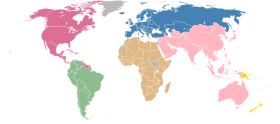
Africa Europe North,
Central America
and the CaribbeanOceania South America See also International club women's football.Categories:- Copa Sudamericana
- CONMEBOL club competitions
Wikimedia Foundation. 2010.

